Wir haben die Datei ‘wp-config.php’ unzählige Male bearbeitet, um erweiterte Funktionen einzurichten, Probleme mit der Datenbankverbindung zu beheben oder die lokale Entwicklung zu erleichtern.
Es ist eine dieser Dateien, mit denen man immer dann arbeitet, wenn man etwas tiefer in die Funktionsweise von WordPress einsteigen möchte. Und wenn man erst einmal weiß, wo man suchen muss, ist es ziemlich einfach, damit zu arbeiten.
Diese Datei steuert einige der wichtigsten Einstellungen Ihrer Website – wie Datenbankzugriff, Debug-Modus und Sicherheitsschlüssel. Sie ist so etwas wie die versteckte Schalttafel, die dafür sorgt, dass Ihre Website reibungslos läuft.
In dieser Anleitung zeigen wir Ihnen, wie Sie die Datei `wp-config.php` mit verschiedenen Werkzeugen sicher finden und bearbeiten können. So können Sie die gewünschten Änderungen vornehmen, ohne sich Sorgen machen zu müssen, dass etwas kaputt geht.
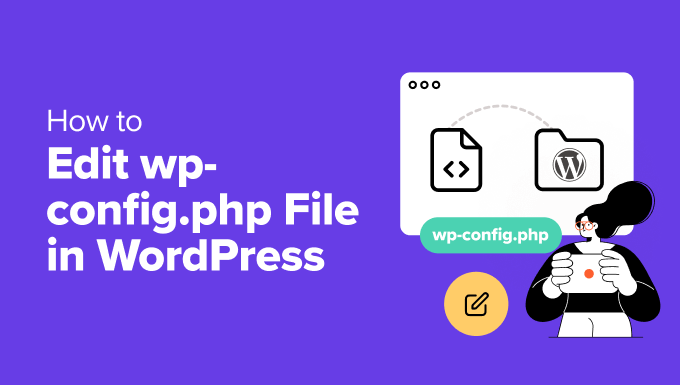
Im Folgenden finden Sie eine Liste der Themen, die wir in diesem Leitfaden behandeln werden:
- What Is the wp-config.php File?
- Create a Backup Before You Edit wp-config.php 💾
- How to Access and Edit the wp-config.php File Safely
- Understanding the wp-config.php File
- MySQL Settings in wp-config.php File
- Authentication Unique Keys and Salts
- WordPress Database Table Prefix
- WordPress Debugging Mode
- Absolute Path Settings
- Useful wp-config.php Hacks and Settings
- Changing MySQL Port and Sockets in WordPress
- Changing WordPress URLs Using wp-config.php File
- Changing Uploads Directory Using The wp-config.php File
- Disable Automatic Updates in WordPress
- Limit Post Revisions in WordPress
- Video Tutorial
- Next Steps to Power Up Your WordPress Skills
Was ist die Datei wp-config.php?
Die Datei `wp-config.php` ist ein wichtiger Bestandteil jeder selbst gehosteten WordPress Website. Sie enthält wichtige Einstellungen, die WordPress helfen, sich mit Ihrer Datenbank zu verbinden und reibungslos zu funktionieren.
Diese Datei ist nicht im Standard-Download von WordPress enthalten. Sie wird während des Installationsprozesses automatisch erstellt, wenn Sie Ihre Datenbankdetails eingeben.
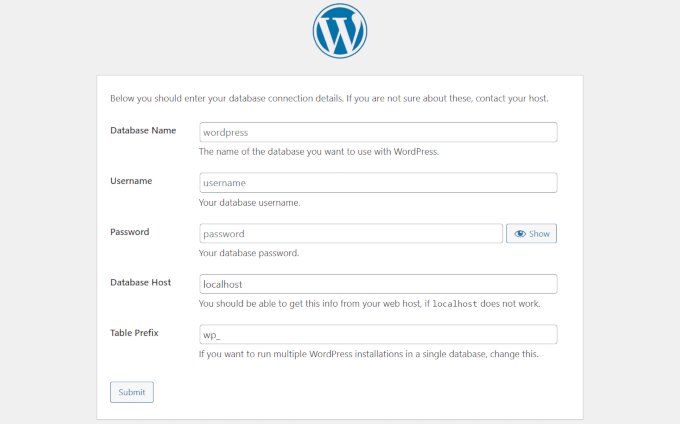
Ohne die richtigen Angaben in dieser Datei kann Ihre Website keine Verbindung zur Datenbank herstellen. In diesem Fall kann die gefürchtete Meldung “Fehler beim Herstellen einer Datenbankverbindung” erscheinen.
Neben den Datenbankdetails kann diese Datei auch Einstellungen für die Fehlersuche, Sicherheitsschlüssel, Speicherbegrenzungen und mehr enthalten. Darauf gehen wir später in diesem Artikel ein.
Die meisten Menschen müssen die Datei “wp-config.php” nicht sehr oft anfassen. Aber wenn Sie wissen, wie sie funktioniert – und wie Sie sie sicher bearbeiten können -, haben Sie mehr Kontrolle über Ihre WordPress Website.
Wenn Sie hier sind, sind Sie wahrscheinlich bereit, eine Änderung vorzunehmen. Wir zeigen Ihnen, wie Sie diese Datei am sichersten bearbeiten können, ohne Probleme zu verursachen.
💡 S ie sind sich nicht sicher, ob Sie das Risiko eingehen wollen, Ihre Website zu zerstören?
Wenn Sie nicht weiterkommen oder nervös sind, können Sie unseren WordPress-Notfallsupport in Anspruch nehmen. Gegen eine geringe Gebühr werden unsere WordPress-Ingenieure die Änderungen für Sie vornehmen, ohne Ihre Website und Ihre Kunden zu stören.
Erstellen Sie ein Backup, bevor Sie wp-config.php bearbeiten 💾.
Die Datei `wp-config.php` steuert wichtige Teile Ihrer WordPress Website, und schon ein kleiner Fehler darin kann Ihre Website offline nehmen.
Deshalb empfehlen wir immer, ein vollständiges WordPress-Backup zu erstellen, bevor Sie irgendwelche Änderungen vornehmen.
Mit einer Sicherungskopie sind Ihre Inhalte, Einstellungen und Dateien geschützt – und Sie können alles wiederherstellen, falls etwas schief geht.
Der beste Weg, WordPress zu sichern, ist die Verwendung von Duplicator. Es ist unsere beste Lösung und für die meisten Benutzer das beste WordPress Backup Plugin. Sie können Ihre Website mit nur wenigen Klicks sichern.
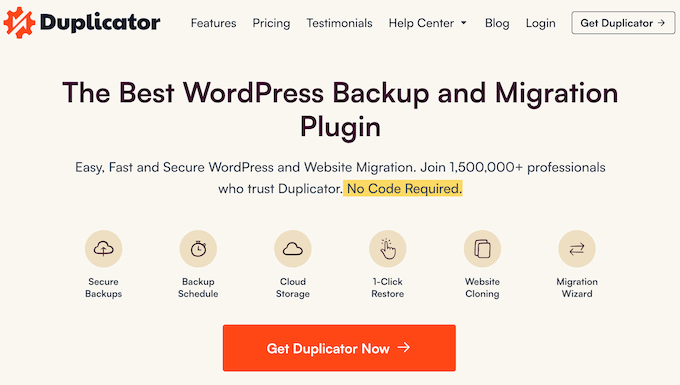
Hinweis: Es gibt auch eine kostenlose Version von Duplicator. Für Funktionen wie geplante Backups und Cloud-Speicher empfehlen wir den kostenpflichtigen Plan.
Warum empfehlen wir Duplicator?
Wir empfehlen Duplicator, weil wir es auf unseren eigenen Websites, einschließlich WPBeginner, für Backups verwenden. Es hat die Sicherheit und Stabilität unserer Websites entscheidend verbessert. Weitere Details finden Sie in unserer vollständigen Rezension zu Duplicator.
Sicherer Zugriff und Bearbeitung der Datei wp-config.php
Die Datei “wp-config.php” befindet sich auf Ihrem WordPress Hosts Server, direkt im Stammordner Ihrer Website.
Sie können darauf zugreifen, indem Sie sich mit einem FTP-Client oder dem Dateimanager in Ihrem Hosting-Control-Panel mit Ihrer Website verbinden.
In der Regel bevorzugen wir FTP, um mehr Kontrolle zu haben. Unter Windows funktionieren Werkzeuge wie FileZilla, WinSCP oder SmartFTP gut. Mac Benutzer können FileZilla, Transmit oder CyberDuck ausprobieren.
Verbinden Sie sich zunächst über Ihren FTP-Client mit Ihrer Website. Sie benötigen dazu Ihre FTP-Anmeldedaten, die Sie von Ihrem Hosts erhalten. Wenn Sie sie nicht kennen, fragen Sie einfach das Support-Team Ihres Hosts.
Sobald Sie verbunden sind, öffnen Sie den Stammordner. Dort sehen Sie weitere Ordner wie wp-content, wp-includes und wp-admin – dort befindet sich die Datei “wp-config.php”.
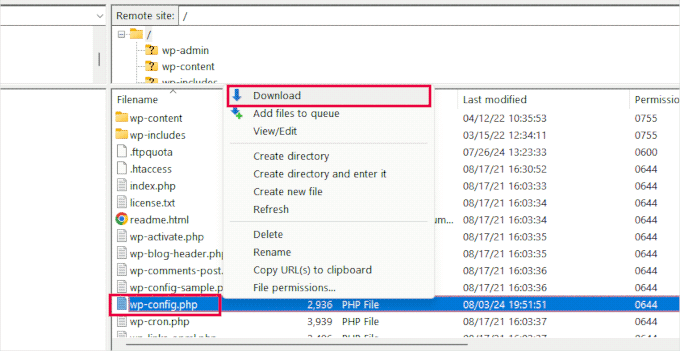
Klicken Sie mit der rechten Maustaste auf die Datei und wählen Sie “Herunterladen”, um sie auf Ihrem Computer zu speichern.
Als nächstes öffnen Sie die Datei mit einem einfachen Texteditor wie Notepad oder TextEdit. Wir haben beide verwendet – sie eignen sich hervorragend für einfache Bearbeitungen.
Nachdem Sie Ihre Änderungen vorgenommen haben, kehren Sie zu Ihrem FTP-Client zurück und laden Sie die Datei in denselben Ordner auf Ihrem Server hoch.
Ihr FTP-Client wird Sie fragen, ob Sie die vorhandene Datei überschreiben möchten. Wählen Sie “Überschreiben” und klicken Sie auf OK, um den Upload abzuschließen.
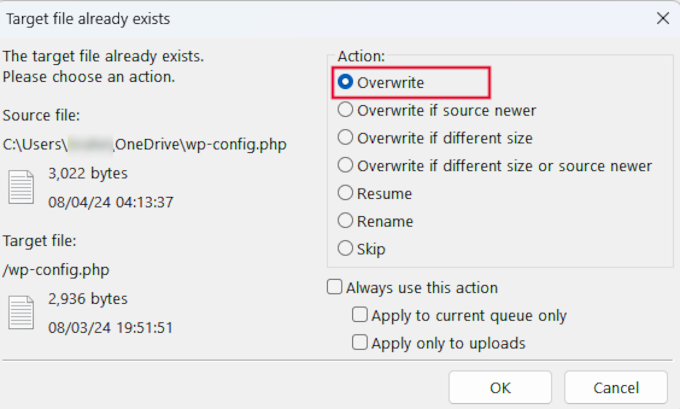
Die Datei wp-config.php verstehen
Bevor Sie beginnen, sollten Sie sich den vollständigen Code der Standard-Datei wp-config.php ansehen. Sie können auch ein Beispiel dieser Datei hier sehen.
1 2 3 4 5 6 7 8 9 10 11 12 13 14 15 16 17 18 19 20 21 22 23 24 25 26 27 28 29 30 31 32 33 34 35 36 37 38 39 40 41 42 43 44 45 46 47 48 49 50 51 52 53 54 55 56 57 58 59 60 61 62 63 64 65 66 67 68 69 70 71 72 73 74 75 76 77 78 79 80 81 82 83 84 85 86 87 88 89 90 91 92 93 94 95 96 | <?php/** * The base configuration for WordPress * * The wp-config.php creation script uses this file during the installation. * You don't have to use the website, you can copy this file to "wp-config.php" * and fill in the values. * * This file contains the following configurations: * * * Database settings * * Secret keys * * Database table prefix * * ABSPATH * * @link https://developer.wordpress.org/advanced-administration/wordpress/wp-config/ * * @package WordPress */// ** Database settings - You can get this info from your web host ** ///** The name of the database for WordPress */define( 'DB_NAME', 'database_name_here' );/** Database username */define( 'DB_USER', 'username_here' );/** Database password */define( 'DB_PASSWORD', 'password_here' );/** Database hostname */define( 'DB_HOST', 'localhost' );/** Database charset to use in creating database tables. */define( 'DB_CHARSET', 'utf8' );/** The database collate type. Don't change this if in doubt. */define( 'DB_COLLATE', '' );/**#@+ * Authentication unique keys and salts. * * Change these to different unique phrases! You can generate these using * the {@link https://api.wordpress.org/secret-key/1.1/salt/ WordPress.org secret-key service}. * * You can change these at any point in time to invalidate all existing cookies. * This will force all users to have to log in again. * * @since 2.6.0 */define( 'AUTH_KEY', 'put your unique phrase here' );define( 'SECURE_AUTH_KEY', 'put your unique phrase here' );define( 'LOGGED_IN_KEY', 'put your unique phrase here' );define( 'NONCE_KEY', 'put your unique phrase here' );define( 'AUTH_SALT', 'put your unique phrase here' );define( 'SECURE_AUTH_SALT', 'put your unique phrase here' );define( 'LOGGED_IN_SALT', 'put your unique phrase here' );define( 'NONCE_SALT', 'put your unique phrase here' );/**#@-*//** * WordPress database table prefix. * * You can have multiple installations in one database if you give each * a unique prefix. Only numbers, letters, and underscores please! */$table_prefix = 'wp_';/** * For developers: WordPress debugging mode. * * Change this to true to enable the display of notices during development. * It is strongly recommended that plugin and theme developers use WP_DEBUG * in their development environments. * * For information on other constants that can be used for debugging, * visit the documentation. * * @link https://developer.wordpress.org/advanced-administration/debug/debug-wordpress/ */define( 'WP_DEBUG', false );/* Add any custom values between this line and the "stop editing" line. *//* That's all, stop editing! Happy publishing. *//** Absolute path to the WordPress directory. */if ( ! defined( 'ABSPATH' ) ) { define( 'ABSPATH', __DIR__ . '/' );}/** Sets up WordPress vars and included files. */require_once ABSPATH . 'wp-settings.php'; |
Jeder Abschnitt der Datei wp-config.php ist in der Datei selbst gut dokumentiert. Fast alle Einstellungen werden hier über PHP-Konstanten definiert.
1 | define( 'constant_name' , 'value'); |
Schauen wir uns die einzelnen Abschnitte in der Datei wp-config.php genauer an.
MySQL-Einstellungen in der Datei wp-config.php
Die Einstellungen für Ihre WordPress-Datenbankverbindung werden im Abschnitt “Datenbankeinstellungen” der Datei wp-config.php angezeigt.
Um diesen Abschnitt auszufüllen, benötigen Sie Ihren MySQL Host, den Datenbanknamen, den Benutzernamen und das Passwort.
1 2 3 4 5 6 7 8 9 10 11 12 13 14 15 16 17 18 | // ** Database settings - You can get this info from your web host ** ///** The name of the database for WordPress */define( 'DB_NAME', 'database_name_here' );/** Database username */define( 'DB_USER', 'username_here' );/** Database password */define( 'DB_PASSWORD', 'password_here' );/** Database hostname */define( 'DB_HOST', 'localhost' );/** Database charset to use in creating database tables. */define( 'DB_CHARSET', 'utf8' );/** The database collate type. Don't change this if in doubt. */define( 'DB_COLLATE', '' ); |
Hier finden Sie eine Liste der Konstanten in diesem Abschnitt und ihrer Funktion.
| Constant Name | Description |
|---|---|
| DB_NAME | The name of the database for WordPress. |
| DB_USER | The username used to access the WordPress database. |
| DB_PASSWORD | The password for the database username. |
| DB_HOST | The hostname of the database server (usually ‘localhost’). |
| DB_CHARSET | The hostname of the database server (usually ‘localhost’). |
| DB_COLLATE | The collation type for the database (usually left blank). |
Um diese Werte einzugeben, benötigen Sie Datenbankinformationen, die Sie im Kontrollpanel Ihres Webhosting-Kontos finden.
Je nach Hosting-Anbieter kann Ihr Kontrollpanel etwas anders aussehen als in den folgenden Screenshots. In diesem Fall müssen Sie in Ihrem Konto nach dem Abschnitt “Datenbanken” suchen.
Wenn Sie z. B. Bluehost verwenden, melden Sie sich zunächst bei Ihrem Konto für das Hosting an. Klicken Sie dann unter Ihrer Website auf “Einstellungen”.
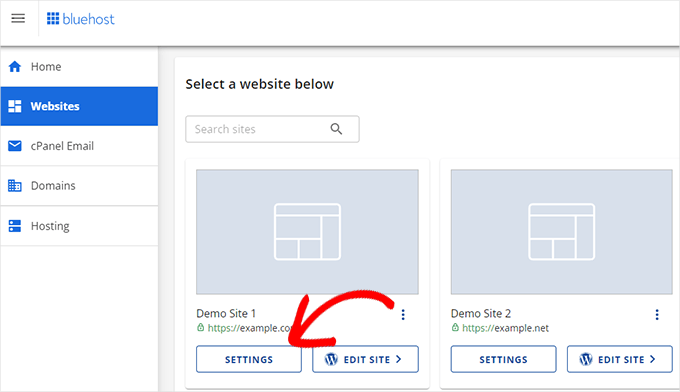
Hier werden Ihnen verschiedene Einstellungen für Ihre Website angezeigt.
Wechseln Sie auf den Tab “Erweitert” und klicken Sie dann auf “Verwalten” neben dem Abschnitt “cPanel”.
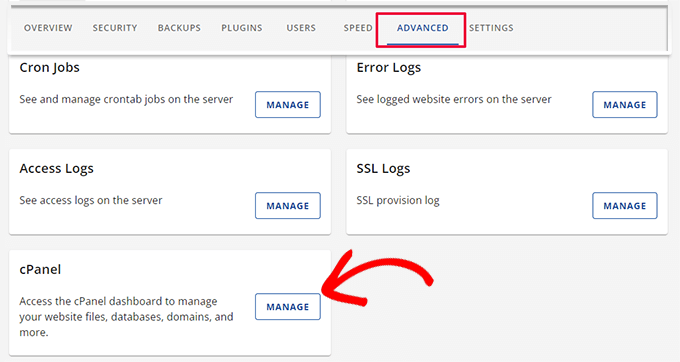
Dadurch wird die cPanel-Oberfläche in einem neuen Browser Tab geöffnet.
Von hier aus müssen Sie zum Abschnitt “Datenbanken” blättern und auf “MySQL-Datenbanken” klicken.
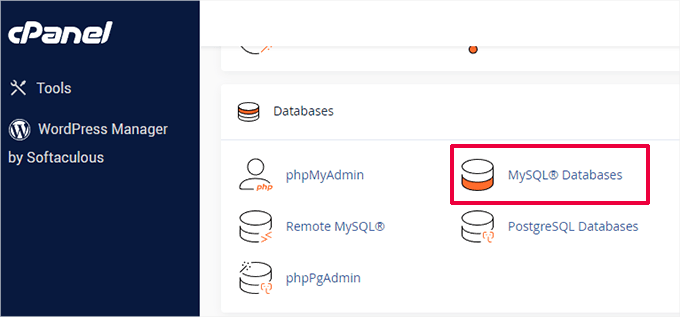
Auf der Seite MySQL-Datenbanken finden Sie die Liste Ihrer aktuellen Datenbank, Ihren Benutzernamen und Ihr Passwort.
Wenn Sie Ihre WordPress-Datenbank oder Ihren MySQL-Benutzernamen und Ihr Passwort nicht finden können, müssen Sie sich an Ihren Webhost wenden.
Was sind DB_CHARSET und DB_COLLATE in der Datei wp-config.php?
Die Einstellung “DB_CHARSET” gibt den Zeichensatz für Ihre WordPress-Datenbanktabellen an. Der Standard ist utf8, der die meisten Sprachen unterstützt und eine breite Kompatibilität gewährleistet.
Die Einstellung “DB_COLLATE” legt fest, wie die Datenbank die Zeichen sortiert und vergleicht.
Wir empfehlen, es leer zu lassen und MySQL die Standard-Kollation für den angegebenen Zeichensatz verwenden zu lassen (utf8_general_ci für utf8).
Authentifizierung Eindeutige Schlüssel und Salze
Authentifizierungsschlüssel und -salze sind Sicherheitsfunktionen in der Datei wp-config.php. Sie bieten zusätzlichen Schutz für Ihre WordPress-Installation, indem sie eine starke Verschlüsselung der in den Cookies der Benutzer gespeicherten Informationen gewährleisten.
1 2 3 4 5 6 7 8 9 10 11 12 13 14 15 16 17 18 19 20 21 | /**#@+ * Authentication unique keys and salts. * * Change these to different unique phrases! You can generate these using * the {@link https://api.wordpress.org/secret-key/1.1/salt/ WordPress.org secret-key service}. * * You can change these at any point in time to invalidate all existing cookies. * This will force all users to have to log in again. * * @since 2.6.0 */define( 'AUTH_KEY', 'put your unique phrase here' );define( 'SECURE_AUTH_KEY', 'put your unique phrase here' );define( 'LOGGED_IN_KEY', 'put your unique phrase here' );define( 'NONCE_KEY', 'put your unique phrase here' );define( 'AUTH_SALT', 'put your unique phrase here' );define( 'SECURE_AUTH_SALT', 'put your unique phrase here' );define( 'LOGGED_IN_SALT', 'put your unique phrase here' );define( 'NONCE_SALT', 'put your unique phrase here' );/**#@-*/ |
Es gibt insgesamt acht verschiedene Schlüssel und Salze. Jedes Schlüssel- und Salzpaar ist eine zufällige, lange Zeichenfolge aus Textnummern und Sonderzeichen.
Die einzelnen Tasten haben folgende Funktionen:
| Constant Name | Description |
|---|---|
| AUTH_KEY | Authenticate cookies and ensure data integrity. |
| SECURE_AUTH_KEY | Secure the authentication cookie when using SSL. |
| LOGGED_IN_KEY | Validate logged-in cookies. |
| NONCE_KEY | Protect nonces (numbers used once) from being guessed. |
| AUTH_SALT | Adds extra security to the authentication process. |
| SECURE_AUTH_SALT | Adds extra security to the authentication process. |
| LOGGED_IN_SALT | Adds extra security to the logged-in process. |
| NONCE_SALT | Adds extra security to the nonce creation and verification process. |
Sie können neue Schlüssel generieren, indem Sie den Generator für geheime Schlüssel auf WordPress.org besuchen. Sie können sie auch später ändern, wenn Sie vermuten, dass jemand versucht, auf Ihren WordPress-Administrationsbereich zuzugreifen.
Weitere Informationen finden Sie in unserem Leitfaden zu WordPress-Sicherheitsschlüsseln.
WordPress-Datenbank-Tabellenpräfix
Standardmäßig fügt WordPress allen Tabellen, die es in der Datenbank erstellt, das Präfix “wp_” hinzu.
Es wird empfohlen, das Präfix der WordPress-Datenbanktabelle während der Installation in etwas Zufälliges zu ändern.
Dies erschwert es Hackern, Ihre WordPress-Tabellen zu erraten, und schützt Sie vor einigen gängigen SQL-Injection-Angriffen.
1 2 3 4 5 6 7 | /** * WordPress database table prefix. * * You can have multiple installations in one database if you give each * a unique prefix. Only numbers, letters, and underscores please! */$table_prefix = 'wp_'; |
Wichtig ⚠️: Bitte beachten Sie, dass Sie diesen Wert für eine bestehende WordPress Website nicht ändern können. Um diese Einstellungen auf einer bestehenden WordPress Website zu ändern, folgen Sie den Anweisungen in unserem Artikel zum Ändern des WordPress Datenbankpräfixes.
WordPress-Debugging-Modus
Diese Einstellung ist besonders nützlich für Benutzer, die die Entwicklung von WordPress erlernen oder Fehler beheben wollen.
Standardmäßig blendet WordPress Hinweise aus, die von PHP bei der Ausführung von Code erzeugt werden. Wenn Sie den Debug-Modus auf “true” setzen, werden diese Meldungen angezeigt.
Dies liefert Entwicklern wichtige Informationen für die Fehlersuche. Sie sind auch hilfreich, wenn Sie versuchen, Probleme auf einer WordPress Website zu beseitigen.
1 2 3 4 5 6 7 8 9 10 11 12 13 | /** * For developers: WordPress debugging mode. * * Change this to true to enable the display of notices during development. * It is strongly recommended that plugin and theme developers use WP_DEBUG * in their development environments. * * For information on other constants that can be used for debugging, * visit the documentation. * * @link https://developer.wordpress.org/advanced-administration/debug/debug-wordpress/ */define( 'WP_DEBUG', false ); |
Alternativ dazu können Sie auch ein Protokoll über Fehler und Hinweise führen.
Ausführlichere Anweisungen finden Sie in unserem Tutorial zur Aktivierung des Debug-Modus in WordPress.
Absolute Pfadeinstellungen
Der letzte Teil der wp-config-Datei definiert den absoluten Pfad. Diese Anweisung teilt WordPress mit, wo die WordPress-Kerndateien zu finden sind.
Nach dieser Anweisung wird der ABSPATH verwendet, um die Datei wp-settings.php zu laden.
1 2 3 4 5 6 7 | /** Absolute path to the WordPress directory. */if ( ! defined( 'ABSPATH' ) ) { define( 'ABSPATH', __DIR__ . '/' );}/** Sets up WordPress vars and included files. */require_once ABSPATH . 'wp-settings.php'; |
Diese beiden Einstellungen sollten nicht verändert werden.
Um zu verstehen, wie WordPress Dateien lädt, werfen Sie einen Blick auf unsere Erklärung, wie WordPress hinter den Kulissen funktioniert. Darin erfahren Sie Schritt für Schritt, wie die WordPress-Kernsoftware funktioniert.
Nützliche wp-config.php Hacks und Einstellungen
Wir haben bisher die Standardeinstellungen der wp-config.php behandelt. Nun wollen wir einige zusätzliche Einstellungen untersuchen.
Diese Optionen sind optional und können bei Bedarf verwendet werden. Sie können Ihnen bei der Problembehandlung helfen und viele häufige Fehler in WordPress beheben.
Ändern von MySQL Port und Sockets in WordPress
Wenn Ihr WordPress Hosting-Anbieter alternative Ports für den MySQL-Host verwendet, müssen Sie Ihren DB_HOST-Wert so ändern, dass er die Portnummer enthält.
Hinweis: Es handelt sich nicht um eine neue Zeile, sondern Sie müssen den vorhandenen Wert DB_HOST bearbeiten.
1 | define( 'DB_HOST', 'localhost:5067' ); |
Vergessen Sie nicht, die Portnummer 5067 in die von Ihrem Hosts bereitgestellte Portnummer zu ändern.
Wenn Ihr Hosts Sockets und Pipes für MySQL verwendet, müssen Sie es wie folgt hinzufügen:
1 | define( 'DB_HOST', 'localhost:/var/run/mysqld/mysqld.sock' ); |
Ändern von WordPress URLs mit der Datei wp-config.php
Möglicherweise müssen Sie die WordPress URLs ändern, wenn Sie eine WordPress Website auf einen neuen Domainnamen verschieben.
Sie können diese URLs ändern, indem Sie die Seite Einstellungen ” Allgemein aufrufen.
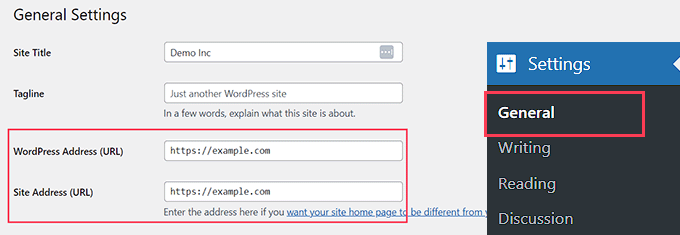
Sie können diese URLs auch in der Datei wp-config.php ändern. Dies ist praktisch, wenn Sie aufgrund des Fehlers “zu viele Verweise” nicht auf den WordPress-Administrationsbereich zugreifen können.
Fügen Sie einfach diese beiden Zeilen in Ihre wp-config.php-Datei ein:
1 2 | define('WP_HOME','http://example.com');define('WP_SITEURL','http://example.com'); |
Vergessen Sie nicht, example.com durch Ihren Domänennamen zu ersetzen.
Sie müssen auch bedenken, dass Suchmaschinen www.example.com und example.com als zwei verschiedene Positionen behandeln (siehe www vs. non-www – Was ist besser für SEO?).
Wenn Ihre Website mit einem www-Präfix indexiert ist, müssen Sie Ihren Domänennamen entsprechend hinzufügen.
Ändern des Verzeichnisses für Uploads mit der Datei wp-config.php
Standardmäßig speichert WordPress alle Ihre Uploads im Verzeichnis/wp-content/uploads/.
Wenn Sie Ihre Mediendateien an einer anderen Position speichern möchten, können Sie diese Codezeile in Ihrer wp-config.php-Datei hinzufügen:
1 | define( 'UPLOADS', 'wp-content/media' ); |
Beachten Sie, dass der Pfad des Uploads-Verzeichnisses relativ zum ABSPATH ist, der automatisch in WordPress festgelegt wird. Das Hinzufügen eines absoluten Pfades funktioniert hier nicht.
Weitere Informationen finden Sie in unserer ausführlichen Anleitung zum Ändern der Standard Position für den Upload von Medien in WordPress.
Automatische Updates in WordPress deaktivieren
In WordPress sind automatische Updates standardmäßig aktiviert. Dadurch können WordPress Websites automatisch aktualisiert werden, wenn eine kleinere Aktualisierung verfügbar ist.
Wenn auf Ihrer Website zum Beispiel WordPress 6.6 läuft und ein Sicherheitsupdate 6.6.1 veröffentlicht wird, installiert WordPress das Update automatisch.
Wenn WordPress 6.7 jedoch veröffentlicht wird, werden Sie aufgefordert, das Update zu initiieren.
Obwohl automatische Updates für die Sicherheit wichtig sind, befürchten viele Benutzer, dass sie auch ihre Website beschädigen und unzugänglich machen können.
Wenn Sie diese Codezeile in Ihre wp-config.php-Datei einfügen, deaktivieren Sie alle automatischen Updates auf Ihrer WordPress Website:
1 | define( 'WP_AUTO_UPDATE_CORE', false ); |
Weitere Informationen finden Sie in unserer Anleitung zum Deaktivieren von automatischen Updates in WordPress.
Beitragsänderungen in WordPress einschränken
WordPress verfügt über eine integrierte Automatische Speicherung und Revisionen. In unserem Tutorial erfahren Sie, wie Sie Änderungen in WordPress mit Beitragsrevisionen rückgängig machen können.
Überarbeitungen nehmen auf den meisten Websites nur wenig Leerzeichen in Anspruch. Allerdings haben wir bei einigen unserer größeren Websites einen erheblichen Anstieg der Größe der Datenbanksicherung festgestellt.
Wenn Sie eine große Website betreiben, können Sie die Anzahl der Überarbeitungen, die Sie in der Datenbank speichern möchten, begrenzen.
Fügen Sie einfach diese Codezeile in Ihre wp-config.php-Datei ein, um die Anzahl der für einen Beitrag gespeicherten Revisionen zu begrenzen:
1 | define( 'WP_POST_REVISIONS', 3 ); |
Ersetzen Sie 3 durch die Anzahl der Revisionen, die Sie speichern möchten.
WordPress verwirft nun automatisch ältere Revisionen. Ihre älteren Beiträge werden jedoch weiterhin in Ihrer Datenbank gespeichert. In unserem Tutorial erfahren Sie, wie Sie alte Beiträge in WordPress löschen können.
Video-Anleitung
Wenn Sie auch eine visuelle Anleitung sehen möchten, schauen Sie sich unser YouTube-Tutorial unten an:
Die nächsten Schritte zur Verbesserung Ihrer WordPress-Kenntnisse
Jetzt, wo Sie wissen, wie Sie die Datei `wp-config.php` bearbeiten können, sind Sie vielleicht neugierig, was Sie noch tun können, um Ihre Website noch besser zu machen. Wir haben ein paar unserer Lieblings-Tutorials zusammengestellt, die Ihnen dabei helfen, Ihre Fähigkeiten weiter zu erforschen und zu verbessern.
Jedes dieser Kapitel enthält praktische Tipps, die wir selbst bei der Verwaltung von WordPress Websites angewendet haben:
- So richten Sie WordPress-Fehlerprotokolle in WP-Config ein
- Meistgesuchte WordPress Tipps, Tricks und Hacks
- Die nützlichsten .htaccess-Tricks für WordPress
- Die nützlichsten zeitsparenden WordPress-Tastaturkürzel
Wir hoffen, dass dieser Artikel Ihnen geholfen hat zu lernen, wie man die Datei wp-config.php in WordPress bearbeitet und was man damit alles anstellen kann. Vielleicht interessiert Sie auch unser Artikel über den Passwortschutz des WordPress-Verzeichnisses oder unsere Tipps zur Verwendung der WordPress-Adminleiste.
Wenn Ihnen dieser Artikel gefallen hat, dann abonnieren Sie bitte unseren YouTube-Kanal für WordPress-Videotutorials. Sie können uns auch auf Twitter und Facebook finden.





Sean Hodge
I believe you should not put any custom rules below the ABSPATH / vars bit down at the bottom, but can you put stuff in any order above those lines?
I’ve got some time on my hands, so I’ve been doing just that, moving stuff around the wp-config file, and removing all the extra fluff between comments. I now know what it all does, and have just left a simple title above each group of rules, such as
/**
* Authentication Unique Keys and Salts.
*/
All the rest of the info about Salts, and debugging etc, is now gone, the stuff that usually appears in green.
What I also did was move the $table_prefix above the Salts, right under the rest of the database info.
I’ve done this all because when I do go in there to modify actual rules, I have to wade my way through what is now useless info, to me.
So far, nothing has exploded, but I thought to ask anyway.
WPBeginner Support
You can change the order of the other content in that file if you wanted, we would warn to be careful when moving that you don’t remove part of the code and normally you should not need to edit your wp-config file.
Admin
Priyanshu Nandi
Which code lines l have to type to increase
Max_input_vars value in this file
WPBeginner Support
That would require changes to your htaccess or a different file, we would recommend reaching out to your host for assistance with what you’re wanting to do.
Admin
WPBeginner Support
Thank you, glad you liked our article
Admin
S.s. Brar
Great article. A must have information for WP admins.
Thanks to Syed and His Team.
WPBeginner Support
Glad our article could be helpful
Admin
Mister No
Hi there, great article. I’m having a problem with my website mobile version. When I try to open it on the mobile phone it says “This site is experiencing technical difficulties”.
What should I do to make my site work again properly?
Thanks in advance
WPBeginner Support
There are a few possible reasons you could be receiving that error, for a starting point you would want to take a look at our guide here: https://www.wpbeginner.com/beginners-guide/beginners-guide-to-troubleshooting-wordpress-errors-step-by-step/
Admin
Paul
Syed, all of a sudden, I can’t upload images (message: missing a temporary folder). Tried to log into WordPress to check support blogs and my username is not recognised.
WPBeginner Support
For that error, you would want to take a look at our guide here: https://www.wpbeginner.com/wp-tutorials/how-to-fix-missing-a-temporary-folder-error-in-wordpress/
Admin
Gale
I am a newbie at wordpress. I uploaded the files via Filezilla and got everything configured. Now how exactly do I actually access my new wp-blog site?
Wp is in the root (public_html) of my website. There were several other file folders that came with Wp. Do I upload them into the public_html folder as well?
WPBeginner Support
If you’re installing WordPress using FTP then you would want to take a look at our guide here:
https://www.wpbeginner.com/how-to-install-wordpress/#installftp
Once the site is set up you would want to go to your login page and log in with the user you created in the installation process:
https://www.wpbeginner.com/beginners-guide/how-to-find-your-wordpress-login-url/
Admin
Esther
Hi, I found out when I was installing WordPress, it was installed in subdirectory Wp and has a result my website can’t go live, my web host said I have to uninstall and install again and I should leave the Wp in the Installation panel blank, my problem is that I have designed the website only to go live and once I uninstall everything will be wiped off, what do I about it, Is there a way to avoid that?
WPBeginner Support
If your host requires the site to be in the main directory, you would want to follow the steps in the WordPress coded to move directories on your existing server
Admin
Mina
Hi,
Thank you for the useful article.
I’m new to this file and I have a basic question. I changed the cache plugin of my site and I need to change the line about it at the beginning of the file to override details of the previous plugin.
Once my file is updated, can I upload it while the cache plugin is activated, and deactivate/reactivate it just after, or do I have to deactivate the plugin before uploading the new wp-config file ?
Thanks for your help.
WPBeginner Support
If your plugin is requiring you to edit your wp-config file you would normally want to edit the wp-config file before activating your new plugin.
Admin
Tiar
hi, i have a wordpress site, i want edit my wordpress site in local, but when i already backup and run my wordpress in local. the page is full of white. can you help me ? im beginner in wordpress
WPBeginner Support
For moving your live site to a local installation, you would want to use the guide here: https://www.wpbeginner.com/wp-tutorials/how-to-move-live-wordpress-site-to-local-server/
Admin
Arthur
I have updated my website (lostkatanning.com) o WP 5.1 (the Gutenberg update) but now, when working on pages or posts it has slowed right down to a crawl and takes forever to respond to even a single key touch. I have tried numerous things from various websites but nothing seems to work. It is starting to do my head in! Any ideas on how to get my speed back?
WPBeginner Support
Hi Arthur,
You can disable the Gutenberg by installing the classic editor plugin to temporarily solve the problem.
Admin
mostafa
Hi
I have a wordpress site. Today I realized my wp-config.php file has been removed for no reason (The reason is not important for me right now).
I want to know what happens if I create another wp-config.php file in the root directory of my website by renaming the wp-config-sample.php file again and set the database name blah blah blah
does it affect my pages and posts? How about the users who have signed up to my website? does it remove them? If the answer is yes, isn’t it better for me to restore backup? The only problem for restoring backup is that it is for two days ago and I posted a new content yesterday and I will miss it.
Thank you very much in advance
WPBeginner Support
Your user and post information is in the database so that information shouldn’t be affected, as long as you connect it to your correct database then there shouldn’t be any change.
Admin
Deepak
Hello,
How do I edit wp-config for setting other smtp using WP smtp plugin ?
Plugin says, “The password is stored in plain text. We highly recommend you setup your password in your WordPress configuration file for improved security; to do this add the lines below to your wp-config.phpfile.
define( ‘WPMS_ON’, true ); define( ‘WPMS_SMTP_PASS’, ‘your_password’ ); ”
Where do I exactly add the code ? It don’t shown in tutorial video or article of Wpbeginner.
WPBeginner Support
Hi Deepak,
You can add this code just before the line that says ‘That’s all, stop editing! Happy blogging’ in your wp-config.php file.
Admin
Riyaz
Thank you for sharing this article, it was simple and easy to understand.
Gaurav Bhatnagar
Hi, I just updated my WordPress to new version manually using FileZilla. My website was working. But then, I did some update inside wp-config.php file. Now the size of that file on server has become ‘0’. Even if I update it from local PC, it still remains ‘0’. What should I do? Now website is not working. I am getting – HTTP Error 500
WPBeginner Support
Hi Gaurav,
You can download a fresh copy of WordPress and extract it on your computer. Inside it you will find a wp-config-sample.php file. You can upload this file to your server and rename it to wp-config.php. You will now need to edit wp-config.php file and enter your WordPress database information.
Admin
Gaurav Bhatnagar
It worked. Thank you.
Greg Bryant
I have an intranet-based wordpress site that I’m setting up. I’m having issues with the proxy configuration in wp-config.php. I’ve tried about everything I know and I still keep getting ‘Proxy Authentication Required” errors.
define(‘WP_PROXY_HOST’, ‘https://proxy.domain.com’);
define(‘WP_PROXY_PORT’, ‘3128’);
define(‘WP_PROXY_USERNAME’, ‘domain\\username’);
define(‘WP_PROXY_PASSWORD’, ‘xxxxxx’);
define(‘WP_PROXY_BYPASS_HOSTS’, ‘localhost’);
Our internal wordpress site can detect that there are new versions of plug-ins but when I try to update I get the proxy authentication error. I’ve tried the variables above with https, http, just proxy.domain.com, the username escaping the \, not escaping the backslash, etc. I looked at the code in class-wp-http-proxy.php and it appears the authentication connects the username with a : and then the password like the http(s)_proxy environment variable. I’ve tried local host for the bypass and an empty string. Our Windows domain uses an file; is there a place to specify this?
I get the same proxy authentication errors trying to download anything from the internal wordpress site.
Error occurred. Something may be wrong with WordPress.org or this server’s configuration. If you continue to have problems, please try the support forums. (WordPress could not establish a secure connection to WordPress.org. Please contact your server administrator.) in /var/www/epkb.mw-process-ctrl.com/public_html/wp-admin/includes/plugin-install.php on line 168
I’m also having an issue with php’s file_get_contents if that’s something wordpress uses. cURL works fine.
Any ideas?
Thanks
WPBeginner Support
Hi Greg,
Please make sure that your localhost environment has curl extension installed and enabled for PHP. Please see our guide on how to fix secure connection error in WordPress for more details.
Admin
Greg Bryant
I have curl installed.
It lists ipV6 as yes but I have ipV6 disabled since our network doesn’t support it.
I think the problem is authenticating with our proxy. On the server I use:
(the \ is escaped when setting the env variables). Above is my wp-content proxy settings.
I’m using ufw for my firewall and have tried with it enabled & disabled with the same results.
Any other ideas?
Thanks
WPBeginner Support
Hi Greg,
We are not sure. You can post on WordPress.org forums may be someone who has faced similar situation can help out.
Jon M
Do the changes take effect immediately after saving the new wp-config file?
WPBeginner Support
Hey Jon,
Yes, they are effectively immediately. However, if you are editing wp-config file in a text editor on your computer, then simply saving your changes may not change the wp-config.php file on your server. You will need to upload the changed wp-config.php file back to your server for changes to take effect.
Admin
Andy
What’s the best way to upload the changed wp-config.php file back to the server?
Can the tutorial be updated with how to upload the adjusted config file? The tutorial seems to be incomplete for the (relative) novice
WPBeginner Support
Hi Andy,
We have linked to our article on how to use FTP to upload WordPress files. It also applies to editing your wp-config.php file. You can simply download your wp-config.php file to your computer using FTP. Edit it to make your desired changes and then upload it back using the same FTP client.
Hope this helps.
ayush
I did something silly , i removed the www part from wp site url under Setting-General . Now admin panel is getting redirected to wordpress one. i used your steps to copy both lines with modification and uploaded via ftp . No luck .Plz help
Boris
Excellent post. I am a newbie and learned a lot.
I have an issue with my site. It looks like I have been hacked. I ran WordFence scan and it caught a line of code in my wp-config.php file that it flagged as not belonging there. Following is the code:
My question is this. Can I remove the "@include…" from the file without screwing up the .php file.
Any guidance will be appreciated.
WPBeginner Support
Hi Boris,
Is the file part of the core WordPress software, a plugin, or a theme? If yes, then download a fresh copy of WordPress core, plugins, or theme the file belongs to and then upload the new file.
You can also download the file to your computer before editing the code as a backup. If anything goes wrong you can then upload it back.
Admin
Saud Razzak
Great post, glad I read.
Steph
I’m having problems accessing site. I debugged and am getting a list of problems but most seem to come back to this one:
“Notice: get_settings is deprecated since version 2.1.0!
Use get_option() instead. in /usr/local/pem/vhosts/xxxxxx/webspace/siteapps/WordPress-xxxxx/htdocs/wp-includes/functions.php on line 3752″
But line 3752 reads:
” trigger_error( sprintf( __(‘%1$s is deprecated since version %2$s! Use %3$s instead.’), $function, $version, $replacement ) ); ”
So i’ve no idea what to replace. I’m sure this is 101 stuff to you, but I’m really confused!! I would really appreciate your advice, thank you.
Steph
Found your section on disabling plugins – which was a great help as the the site is now viewable whilst I try to resolve. This is the message I see now when logged in WP Admin
” Catchable fatal error: Argument 1 passed to Genesis_Admin_CPT_Archive_Settings::__construct() must be an instance of stdClass, instance of WP_Post_Type given, called in /usr/local/pem/vhosts/xxxxxx/webspace/siteapps/WordPress-xxxxxx/htdocs/wp-content/themes/genesis/lib/admin/menu.php on line 122 and defined in /usr/local/pem/vhosts/xxxxxx/webspace/siteapps/WordPress-xxxxxx/htdocs/wp-content/themes/genesis/lib/admin/cpt-archive-settings.php on line 38 ”
Am in a spot of bother and could really use your help – thank you!
WPBeginner Support
Hey Steph,
Try updating your Genesis child theme. Connect to your website using FTP and download your child theme as a backup. After that delete child theme folder from your website.
Next, download a fresh copy of the theme and install it. If this doesn’t work, then try updating Genesis core itself.
Admin
Hell Men
If i delete salt key can i decrypt wordpress password ?
Sean
Hi,
I did something silly and now can’t get my site to work. Basically I kept my site live at said URL example.com and created a folder where I built the WordPress site example.com/Wordpress. However when I went to put the wordpress site into the root folder after backing everything up I forgot to change the site URL in the dashboard. i basically then removed my entire site and copied everything from the wordpress site into the root URL. It didn’t work – so I thought I would remove everything and restore my site as it was with both the wordpress and the normal site working.
However once I restored all the files the wordpress site now errors with 404 Page not found and I can’t login into the dashboard either.
Any idea how I can restore this? I think it is looking in the root directory and WordPress folder for the site or something similar and it’s causing the error – but how do I fix it?
Thanks
Sean
WPBeginner Support
Hi Sean,
You can update WordPress URLs by adding this code to your wp-config.php file:
define('WP_HOME','http://example.com');define('WP_SITEURL','http://example.com');
Admin
Dan
Hello i would like to have it when i upload an image it gets uploaded to my cloud from wordpress.
i got a url & api key.
Any suggestions would be cool. thanks.
Eeswar Reddy
Best site for WordPress Beginners. Solved my blog problem simply. Thank u so much Sir…
WPBeginner Support
You are welcome Don’t forget to join us on Twitter for more WordPress tips and tutorials.
Don’t forget to join us on Twitter for more WordPress tips and tutorials.
Admin
Karl
Nice instructions, as far as they go. However, I know it is ALSO possible to edit wp-config.php directly through WordPress’ Admin area but it seems to be a closely guarded secret as to HOW to actually do this. I do not have FTP access to my site so I have to use some other method and I’d rather not go chasing down the rabbit hole of trying out various flaky plugins until I find one that actually works. Your assistance as to what menu drill-down to explore in WordPress Admin would be greatly appreciated.
WPBeginner Support
It is not a good idea to edit wp-config.php file inside WordPress admin area. One tiny mistake and you will be locked out of your WordPress site. If you do not have FTP access, you can try editing it via cPanel’s file manager.
Admin
Angela
I don’t want to sound stupid, but please help me understand… are the wp-config.php changes supposed to be made on my Mac or on the host for my website. They are two different machines.
Please help! I keep making changes to my web site and all of a sudden they just do not ‘take’.
Best regards,
Angela
WPBeginner Support
You can make changes to wp-config.php file using an FTP client. It allows you to edit files on your web server. After connecting to your website using an FTP client, you need to locate wp-config.php file and download it to your computer. Make changes it to it using a text editor like TextEdit. Save your changes and then upload the file back to your web server using the FTP client.
Admin
Sharron
Ok, so I added define(‘WP_ALLOW_REPAIR’, true); to my downloaded wp config file with notepad. Now what?
Ray
Once you have done that, you can see the settings by visiting this URL on your blog:
yoursite.com/wp-admin/maint/repair.php
You have 2 buttons
1st – Repair Database
2nd – Repair and Optimize Database
I suggest u click the 1st one and wait for the process to finish.
John Johnson
CODA is an FTP Client as well. Correct?
PiNo
Hi,
For security I add to my .htaccess
<files wp-config.php>
order allow,deny
deny from all
</files>
Kind regards